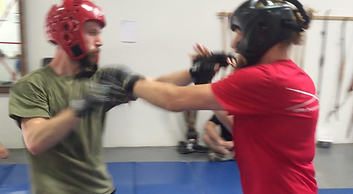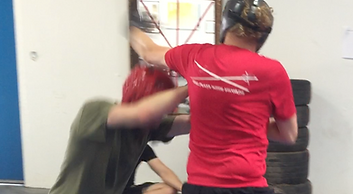

ABRACAR
Medieval and Renaissance heritage
“Cum li braci vegno acusi ben distese per guadagnar in ogni modo le prese...”
“With the arms extended I come to you to gain the grappling in any possible way..”
{Fiore De Liberi, Flos Duellatorum, XV century}
The Mediaeval and Renaissance art of unarmed fighting were based on the natural weapons of the body (arms, legs, etc.) used with the same fencing strategies of armed fencing: intercepting the opponent's weapons, close the line, protect and attack at the same time, using distance, timing, and geometry.
In the ancient school of unarmed fencing we can identify several actions and strategies that develop after intercepting the opponent’s line of attack: prese avantacade e ligadure (trapping and blocking the opponent's arms and legs); Roture (breaking joints and weaker bones of the body); Percusion (striking with hands, arms, elbows, legs and heads); Lesion (injuring with pressure and clintching on soft parts such as eyes, genitals, ears, etc.), Gambarole, Capofitti and Stramazzi (different actions aimed to throw and take down the opponent on vital parts, such as the head, in combination with striking actions).
Abracar is part of the same western martial art tradition such as in Greek and Roman wrestling, boxing or the full mixed combat system that was the Pancrazio: all arts part of a "Gymnastic practice", ritualistic duels, physical and mental practice (mens sana in corpore sano - healthy mind inside a healthy body). It was not by chance that these arts were devoted to Hermes, God of Art and Science, and not to Mars. Abracar, instead, was the same practice in Martial contexts, for the war, the battle and for surviving in combat (concervazione della vita - conservation of life). It was not developed for a game, a duel or a ritual, but for quickly and efficiently escaping from a dangerous situation with the minimal damage.
Indeed, the efficacy and straight logic of Abracar developped from the need of surviving in battlefields, as well as quickly defending in dark medieval streets where people could attack armed with daggers at any time. Compared to its counter parts Lotta, Pugilato or Pancrazio, (also called Zoghi di Concordia - Games of Concord), Abracar shares the use of strategies and techniques (Zoghi), speed (celeritas and presteza) and strength (Fortituto). However compared to Zoghi di Cocordia, Abracar tends to prefer less articulted and sophisticated actions (Zoghi di Concordia are ultimately martial arts and games, atheltic practices and sports: even if they can be hard, dangerous or physically challenging, they always have some rule) to focus instead on quickly finalizing, injuring and escaping (Zoghi d'Ira - Games of Fury or Games of Rage).


Zoghi de Ira : Abracar - Flos Duleatorum - Cd. Pisani Dossi
Fiore de Liberi - 1409
Zoghi de Concordia : Pancrazio - De Arte Gymnastica
Girolamo Mercuriale - 1569



Nova Scrimia sparring in Abracar
Nova Scrimia training in Abracar
Nova Scrimia training in Abracar


Box-Libera ovvero difesa personale
L. Carmine - 1869
Mani Libere: Pugilato and Lotta for self defense
Modern era (XIX and XX century)
“Si puo' pure mettere il colpo di testa all'avversario all'istante di stringervi...”
“It is also possible to strike with the head against your opponent in the moment of grappling..”
{"Box Libera ovvero difesa personale", Luigi Carmine, XIX Century}
In the XIX century, the culture of Gentlemen supported the development and the integration of a more "fencing geometry" in the use of kicking and punching. We can see an evolution from the more brutal "Conservazione della vita" (Conservation of life), which is based on "Zoghi d'Ira" (Games of Fury) like in the case of Abracar, into a milder and cleaner "Difesa Personale" (Self Defense). However, this methods were technically more sophisticated and paralleling other fencing methods (swords, daggers and sticks) of the XIX century. Masters such as Rosarol-Grisettu Scorza (1871), Luigi Carmine (1869), Alberto Cougnet (1898) or Giannino Martinelli (1906) are examples of this school.
Fencing actions and striking are now translated into unarmed fencing: Pugni al petto pel viso, Pugni stoccata, Calci puntati, Calci a falciola, Parate in contrzione, Cedute, Arresti in tempo, Inquarti are integrated together with actions of more ancient heritage like Distorsioni di dita, Distorsioni di braccio, Gamberole, Stramazzi, Girocollo, Balestrate, Prese di slogata. Here can practice parrying, countertiming, stoccate/lunches, exiting on different angles, steps maintaining the measures. etc. together with joint breaks, head take downs, neck injuries, etc.


Box-Libera ovvero difesa personale
L. Carmine - 1869
Nova Scrimia XIX c. Mani Libere

Scherma di Bastone da Passeggio e Difesa Personale - G. Martinelli - 1906

Box-Libera ovvero difesa personale
L. Carmine - 1869

Nova Scrimia sparring in Mani Libere

Nova Scrimia Class of Mani Libere at our US headquarter in Santa Clara - Silicon Valley - Califormia - USA (2016)









